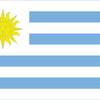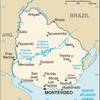Uruguay [+]Compare [E]dit [H]istory
Aliases: Banda Oriental, Cisplatine Province, Oriental Republic of Uruguay, Republica Oriental del UruguayObject «Uruguay» was created due to
Add new object to «Uruguay» or move existing objects here.
Object «Uruguay» has attributes [Show empty attributes][Hide empty attributes]
| Attribute | Value |
|---|---|
| Geography | |
| Area | 176,215 km² |
| Continent | South America |
| Land area | 175,015 km² |
| Water area | 1,200 km² |
| Land boundaries | 1,591 km |
| Border countries |
|
| Coastline | 660 km |
| Mean elevation | 109 m |
| Lowest point | 0 m |
| Highest point | 514 m |
| People | |
| Population | 3,387,605 |
| Official languages |
|
| Religion | Roman Catholic |
| Government | |
| Long country name | Oriental Republic of Uruguay |
| Short country name | Uruguay |
| Long local name | Republica Oriental del Uruguay |
| Short local name | Uruguay |
| Former name |
|
| Government type | Presidential republic |
| Capital | Montevideo |
| Economy | |
| GDP (PPP) | 78,160,000,000 USD |
| GDP (OER) | 59,180,000,000 USD |
| GDP (real growth rate) | 2.7 % |
| GDP - per capita (PPP) | 22,400 USD |
| Gross national saving | 17.2 % of GDP |
| Labor force | 1,748,000 |
| Unemployment rate | 7.6 % |
| Population below poverty line | 9.7 % |
| Budget revenues | 17,660,000,000 USD |
| Budget expenditures | 19,720,000,000 USD |
| Military expenditures | 1.95 % of GDP |
| Taxes and other revenues | 29.8 % of GDP |
| Budget surplus or deficit | -3.5 % of GDP |
| Public debt | 65.7 % of GDP |
| Inflation rate | 6.2 % |
| Central bank discount rate | 9 % |
| Commercial bank prime lending rate | 13.83 % |
| Stock of narrow money | 5,068,000,000 USD |
| Stock of broad money | 5,068,000,000 USD |
| Stock of domestic credit | 20,840,000,000 USD |
| Market value of publicly traded shares | 175,400,000 USD |
| Current account balance | 879,000,000 USD |
| Exports | 11,410,000,000 USD |
| Imports | 8,607,000,000 USD |
| Reserves of foreign exchange and gold | 15,960,000,000 USD |
| External debt | 28,370,000,000 USD |
| National currency | Uruguayan pesos |
| National currency (code) | UYU |
| National currency (symbol) | $U |
| National currency rate to USD | 28.77 |
Montevideo, founded by the Spanish in 1726 as a military stronghold, soon took advantage of its natural harbor to become an important commercial center. Claimed by Argentina but annexed by Brazil in 1821, Uruguay declared its independence four years later and secured its freedom in 1828 after a three-year struggle. The administrations of President Jose BATLLE in the early 20th century launched widespread political, social, and economic reforms that established a statist tradition. A violent Marxist urban guerrilla movement named the Tupamaros, launched in the late 1960s, led Uruguay's president to cede control of the government to the military in 1973. By yearend, the rebels had been crushed, but the military continued to expand its hold over the government. Civilian rule was restored in 1985. In 2004, the left-of-center Frente Amplio Coalition won national elections that effectively ended 170 years of political control previously held by the Colorado and National (Blanco) parties. Uruguay's political and labor conditions are among the freest on the continent.
Similar objects
- [⇄] [+] Angola
- [⇄] [+] Argentina
- [⇄] [+] Dominica
- [⇄] [+] Grenada
- [⇄] [+] Saint Vincent and the Grenadines
Most often compared with
Everyone can something to edit or add.
There was one edit, no edits waiting approval. Last edited by wilkinson.michael(9581), Sep 16, 2019 (65 fields were changed)
Help · Contact us · Disclaimer · Contributors · Developers · Donate


